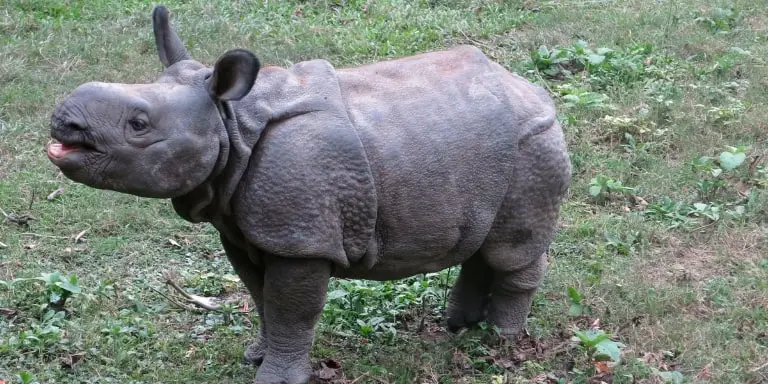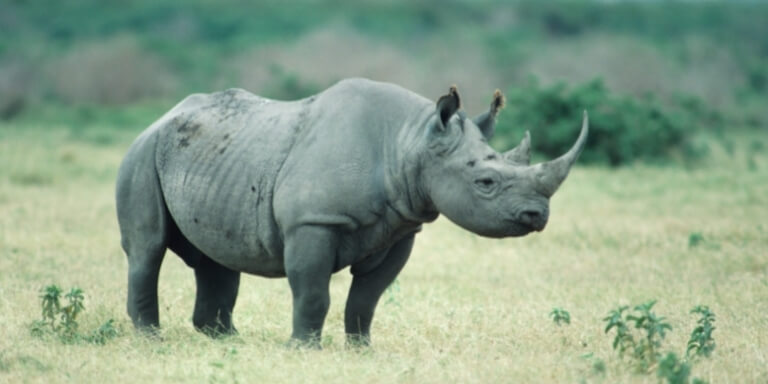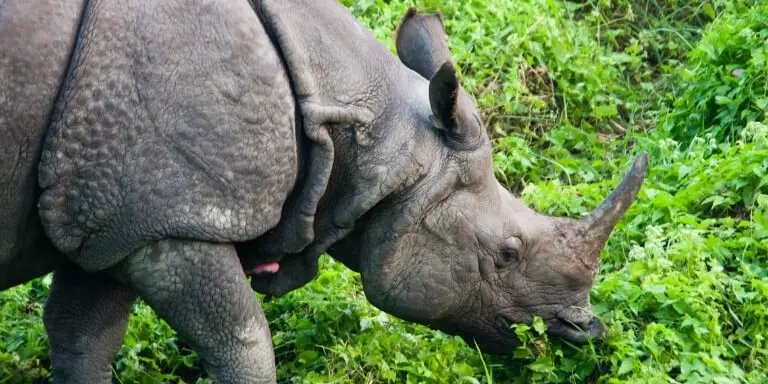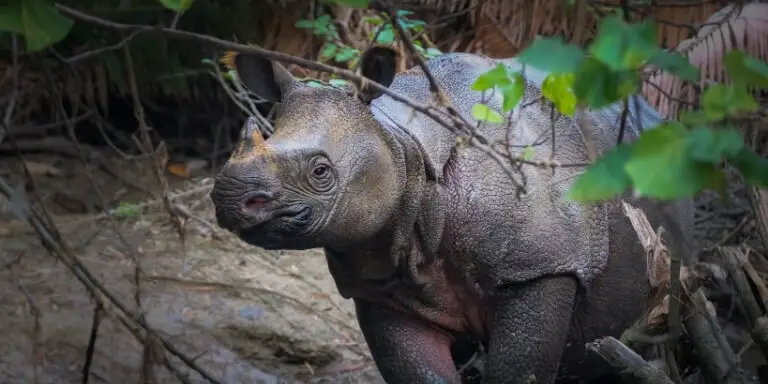Rhinoceroses are undoubtedly one of the largest animals on land. In fact, they are the second-largest land mammal just after the elephants. Their massive bodies are covered with thick armor and weigh a lot. So it isn’t uncommon to wonder how much does a rhino weigh?
Five species of these huge mammals still are roaming the surface of the earth. Among them, the white rhino is the largest of all. Their weight ranges from around 2700 kilograms that are about 6000 pounds. Adults of these larger species have a massive weight of 3 to 5 tons.

Why are rhinos so heavy?
Rhinos have massive bodies. The reason for their weight isn’t so hard to imagine. Their huge shoulders carry a lot of weight. The big muscles also need big and strong bones to sit on. The joints need to be strong and bulky to be able to carry such gigantic bones.
The gigantic body and it’s armor need to lean on to a well-built body structure. It needs good balancing for which it needs strong legs to walk on. Even their horns weigh around 1.5 to 4 kilograms.
They are so heavy that some rhinoceros in the wild were found with several health problems because their bulk was simply too heavy to take the strain.
Many signs of bone health issues such as bone degeneration, infection, etc were found in the extinct and existing species of the horned animal. Many scientists are currently studying the detriment of long-term bone health issues in the giants.
How much do rhinos weigh through different life stages?
An animal can weigh differently in different conditions in its life. Its body is built on what it eats. Many scientists stand amazed at the fact that something that lives on grass can grow that big.
Again, a rhino in the wild may weigh differently than the one in captivity. Different species also weigh differently. Such as the White Rhino is the largest of all and the Sumatran Rhino is the smallest species existing. Their average weight is determined by examining a lot of specimens over many years.
Weight of a rhino baby

At birth, the baby of a White Rhinoceros can weigh from 50 to 60 kilograms. The baby starts walking after a few hours of its birth and lives totally on its mother’s milk for 2 or 3 weeks. The milk has so much fat in it that the baby gains 1.5 to 2 kilograms daily during the first few days of its birth.
After a few weeks, the mother familiarizes her calf with fresh grass. The calf then starts eating its first vegetation but it also drinks breast milk for about 2 years. During this time it grows physically to being an adult and learns survival skills from the mother.
Weight of an adult rhino
Rhinoceros are solitary beings. They are brought up by their single mothers. The fathers never claim the children. The mother feeds the calf with her milk. The rich milk helps it to grow fast.
After some time the calf starts eating grass. The baby reaches its adolescence when it is 2 years old. It still has some growing to do then. Its full weight has not yet been gained. After 3 to 4 years, the giant becomes an adult and can leave the mother and live in the wild alone.
During this time their average weight ranges from 3 to 5 tons. Only a few of today’s existing adult mammal species weigh over a ton and the horned African giant is one of them. Their heaviness remains the same till their death.
How heavy is a Rhino? Different species Weight Comparison
Five species of massive animals are still roaming the planet’s forests and deserts. These include The African White and The Black Rhino, The Greater One-Horned species, The Sumatran Rhinoceroses, and The Javan Rhinoceroses.
Among these, some are larger than others. Their food habits and habitats also vary. As a result, they are also differently heavy.
| Rhino Species | Average Baby Weight | Average Adult Male Weight | Average Adult Female Weight |
|---|---|---|---|
| White Rhinoceros | 40-65 Kg (89-143 lbs) | 2500 Kg (5500 lbs) | 1300 Kg (2850 lbs) |
| Black Rhinoceros | 35-50 Kg (77-111 lbs) | 1400 Kg (3100 lbs) | 900 Kg (1900 lbs) |
| Indian Rhinoceros | 50-65 Kg (77-143 lbs) | 2400 Kg (5300 lbs) | 1600 Kg (3500 lbs) |
| Sumatran Rhinoceros | 40-60 Kg (88-132 lbs) | 900 Kg (1900 lbs) | 500 Kg (1100 lbs) |
| Javan Rhinoceros | 45-60 Kg (100-145 lbs) | 900-2300 Kg (2000-5000 lbs) | 900-2300 Kg (2000-5000 lbs) |
White Rhinoceros

White Rhinoceroses are the biggest Rhinoceros breed alive. But they are also gentler than others. The gestation period of these creatures lasts for about 16 months. The single mother takes care of her child. The child is 40 to 65 kilograms at birth. The calf grows very fast. It gains 1.5 to 2 kilograms daily during the few days of its birth.
Males grow faster than females. After 3 to 4 years an adult can be a lot heavier. All of them crossed the massive scale of 1 ton. Their average weight ranges up to 2700 kilograms. Females are less heavy than males of the same family.
Black Rhinoceros

They are African giants but smaller than the previous ones. Despite their name, they aren’t black in color. They are more ferocious than any other kind.
These giants can be a lot heavier. That is around 800 to 1400 kilograms heavy. Females weigh less than males.
Their gestation can last for about 15 to 16 months. After that, a single calf is born. The calf is about 35 to 50 kilograms at birth, which is about 75 to 110 pounds.
The mother’s rich milk helps the calf to grow a lot faster. They leave their mothers after about 3 to 4 years. But reaching maturity can take over 5 to 6 years. Their heaviness remains the same till their death.
The greater one-horned Rhinoceros

They are found in the tropical forests of India. These Indian species of giants can be about 50 to 65 kilograms at birth. About 60 kilograms is considered to be a good weight for these infants.
After 4 to 6 years the calf reaches its mature age.
During this time, they can weigh from around 1600 to 2700 kilograms, about 4000 to 6000 pounds. The males are heavier than the females. An average male in the wild carries about 2200 kilograms and an average female carries about 1600 kilograms.
Sumatran Rhinoceroses

Sumatran Rhinoceros is the smallest breed of all rhinoceros species. An adult’s body carries about 1300 to 2100 pounds that are 600 to 900 kilograms. Males are heavier than females.
The infants can be about 40 to 60 kilograms that are about 88 to 132 pounds.
Javan Rhinoceroses

An infant can have a weight of 45 to 69 kilograms(88 to 150 pounds). They reach their maturity after 3 to 5 years. During this, they weigh about 900 to 2300 kilograms(Around 2000 to 5000 pounds). The females weigh little more than the males.
Is a rhinoceros heavier than a hippopotamus?

The weight comparison between two different mammals always depends on the families that are being compared. The hippo has 2 living species currently and the rhino has 5 species. If the biggest breed of both mammals is compared, that is the white rhinoceros and the common hippo, the horned giants obviously win.
Rhinoceros and hippopotamuses are the two biggest land mammals currently existing on the planet. The hippo despite being more ferocious than the horned beast is smaller in size.
The average male armored giant can be up to 2700 kilograms heavy. Whereas the average male hippo can only weigh from 1500 to 1800 kilograms.
Again the comparison between the smallest breeds of both animals is totally bizarre. The Sumatran rhinoceros are way heavier than the pygmy hippos. The pygmy hippos are only 400 to 600 pounds heavy. Whereas the Sumatran horned giants are 1300 to 2100 pounds heavy.
Conclusion
Scientists are still studying the weight distribution of these huge animals to learn new things. They believe there is more to know from the question of “how heavy is a rhino?”.
The giant horned animal is the second-largest living mammal on the planet. Though they live on vegetation, their body has a lot stronger structure. Rhinos’ weight changes during the different stages of life. Different species also are differently heavy. Lastly, a rhinoceros is obviously heavier than a hippo.
Related Articles:
Why Do Rhinos Charge? A Tourist Survival Guide
Do Rhinos Have Predators? Top 5 Predators that can kill Rhinos
How to Stop Rhino Poaching | Anti-Poaching Guide
